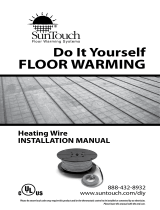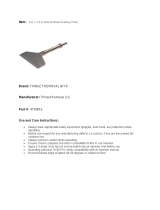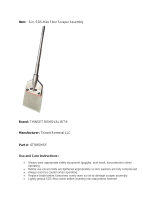
9 of 36 © 2016 Watts Water Technologies
Phase 2 - Electrical Rough-in
To prevent the risk of personal injury and/or death, make sure power is not
applied to the product until it is fully installed and ready for final testing. All
work must be done with power turned off to the circuit being worked on.
STEP 2.1:
Circuit Breaker (Overcurrent Protection)
WarmWire must be protected against overload by a circuit breaker. GFCI type (ground fault
circuit interrupter) or AFCI type (arc-fault circuit interrupter) breakers may be used if desired,
but are not necessary when using SunStat controls with integral GFCI.
The rating of the breaker (see Table 5) is determined by the amp draw of the heating cables.
Add the amp ratings of all cables to be connected to the SunStat control (see Table 2 or the
Nameplate Label on the cable). If the total is less than 12 amps, use a 15 or 20 Amp breaker
(preference is 15 A). If the total is between 12 and 15 amps, use a 20 Amp breaker. If the total
is over 15 A, another circuit will be required with its own breaker and SunStat control.
Circuit Breakers and Supply Wire
Cable(s) Supply Wire Breaker
VAC total amps (AWG)* qty type** rating
120 up to 12 amps 14 1 SP 15 or 20 A
120 up to 15 amps 12 1 SP 20 A
240 up to 12 amps 14 1 DP 15 or 20 A
240 up to 15 amps 12 1 DP 20 A
* Recommended only. Follow local codes for wire gauge size.
** SP= single-pole, DP=double-pole
Table 5
STEP 2.2:
Install Electrical Boxes
SunStat® Thermostat:
Install an extra-deep electrical box for the SunStat Thermostat. Follow the instructions
included with the thermostat for complete information on location and wiring.
SunStat Relay:
Install an extra-deep electrical box for any SunStat Relay(s). The SunStat Relay is used when
more than 15 amps must be controlled by one SunStat Thermostat. Follow the instructions
included with the SunStat Relay for complete information on location and wiring.
Junction Boxes:
If a cable is to be located so its power lead is not long enough to reach the SunStat thermostat
or SunStat Relay directly, a junction box must be installed. Do not attempt to make a connection
to other wiring without a junction box. Use a standard junction box with a cover, mounting
it below the subfloor, in the attic, in the wall, or in another location easily accessible after all
coverings are complete. If the SunStat sensor wire is not long enough to reach the SunStat
thermostat directly, it may be extended. A junction box may be required by local code to
make this connection. Follow the installation instructions included with the SunStat for details.
For construction with an existing wall or where the wall is covered, cut the necessary openings
to mount the electrical boxes listed above. Wait to install the boxes until all wiring is fed into
these locations to make it easier to pull the wire.
It may be possible to tap into an
existing circuit as long as there
is adequate capacity for the
cables(s) and any additional ap-
pliance, such as a hair dryer or
vacuum cleaner. Avoid circuits
which have lighting, motors,
exhaust fans, or hot tub pumps
due to possible interference.



























